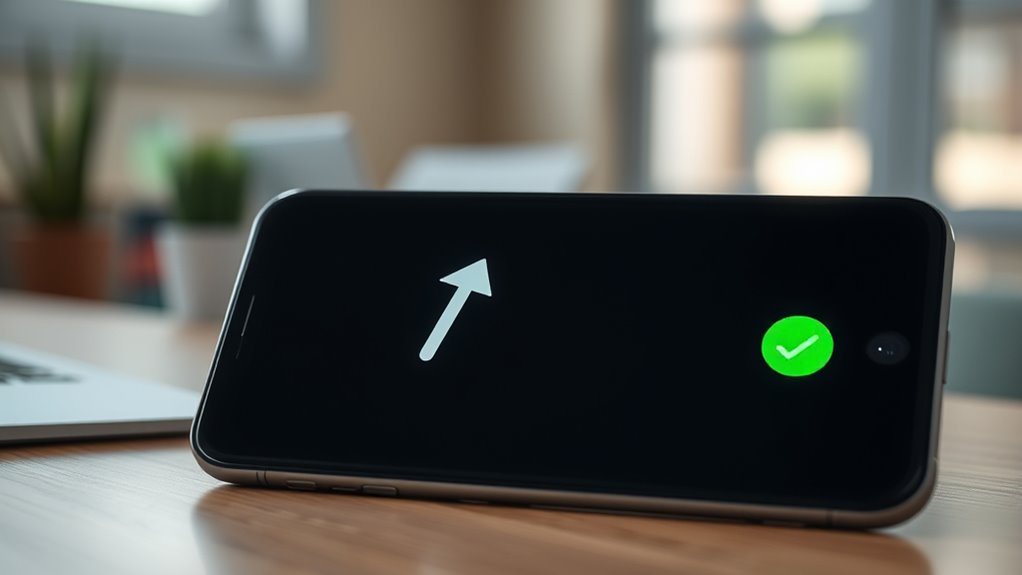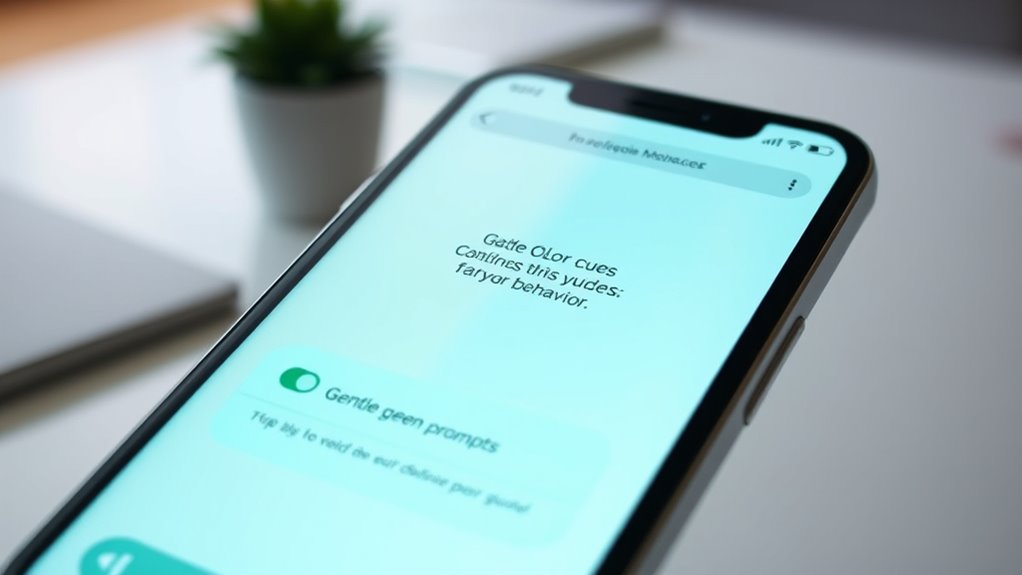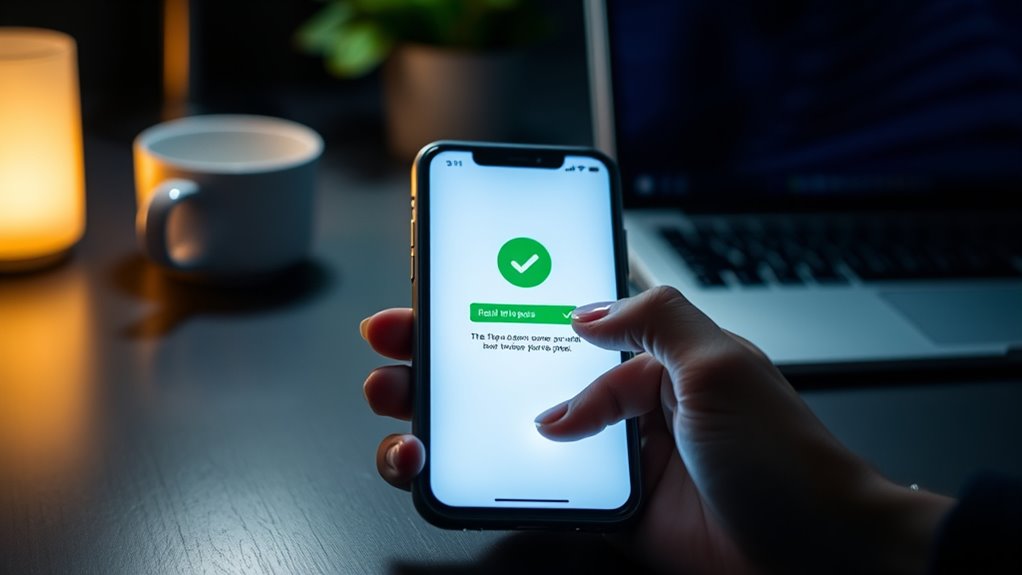To design for behavior change using nudge theory in digital products, focus on subtly influencing decisions through environmental cues that respect user autonomy. Identify key decision points and incorporate visual signals or interface adjustments that guide users toward better choices without restricting options. Prioritize ethical practices by ensuring transparency, privacy, and cultural sensitivity. When you consider these principles, you can create effective nudges that foster positive habits — and there’s more to explore on how to do this thoughtfully.
Key Takeaways
- Utilize subtle environmental cues and visual signals to guide user decisions while respecting their autonomy.
- Leverage behavioral insights and cognitive biases to design context-aware nudges that influence behavior effectively.
- Ensure transparency, privacy, and cultural sensitivity to build trust and ethically promote positive user actions.
- Measure behavioral impacts through quantitative metrics, control groups, and continuous data analysis for ongoing optimization.
- Prioritize ethical principles by maintaining user agency, avoiding manipulation, and fostering trust through responsible design.
Understanding Nudge Theory and Its Principles

Nudge theory explains how small environmental or contextual changes can influence people’s decisions without restricting their options. Rooted in behavioral economics, it leverages our understanding of cognitive biases—those subconscious shortcuts our minds take. By adjusting the context, you can guide choices subtly; for example, placing healthier foods at eye level taps into biases around convenience and visual cues. The core principles emphasize that people often rely on heuristics and are influenced by their environment, not just rational analysis. Nudge strategies don’t force decisions but gently steer individuals toward better options. Recognizing these behavioral tendencies allows you to craft designs that shape behavior naturally and effectively, harnessing the power of environment and context to promote positive actions without limiting freedom of choice. Additionally, using discount codes and promotional offers can incentivize users to engage with your services more readily.
Identifying Opportunities for Behavioral Influence

To identify opportunities for behavioral influence, you need to analyze user goals and understand what motivates their actions. Spot the behavioral triggers that prompt specific responses and look for decision points where choices are made. Recognizing these moments helps you design interventions that effectively guide behavior change. Understanding the divorce process in various jurisdictions can also inform how to apply nudges during legal or procedural decision-making.
Analyzing User Goals
How can you identify the moments when users are most receptive to influence? By analyzing their goals, you uncover these opportunities. Emotional triggers often signal openness; for example, frustration or satisfaction can motivate action. Recognizing cultural context is equally essential, as it shapes what resonates with your users. For instance, certain values or symbols may evoke stronger responses in specific communities. When users’ goals align with emotional cues or cultural nuances, they become more receptive to nudges. Focus on understanding their motivations and barriers, and consider how emotional triggers and cultural context influence their decision-making. This insight helps you design interventions that fit naturally into their mindset, increasing the likelihood of positive behavior change. Additionally, considering cognitive biases can enhance the effectiveness of your nudges by leveraging inherent decision-making tendencies.
Spotting Behavioral Triggers
Identifying behavioral triggers requires keen observation of user interactions and emotional responses. Look for emotional triggers that prompt users to act, such as frustration, excitement, or curiosity, as these moments reveal opportunities to influence behavior. Environmental cues, like notifications, interface placement, or visual signals, can also serve as powerful triggers. Pay attention to how users respond to different elements within your product—when they pause, hesitate, or quickly proceed. These reactions highlight potential triggers that can be leveraged or adjusted. By understanding these cues, you can design interventions that align with natural user responses, making nudges more effective. Recognizing user engagement patterns helps you create a seamless experience that gently guides users toward desired behaviors without overt coercion. Spotting these triggers early helps you create a seamless experience that gently guides users toward desired behaviors without overt coercion.
Recognizing Decision Points
Recognizing decision points involves paying close attention to moments when users are actively choosing whether to continue, modify, or exit an interaction. These moments often reflect cultural influences that shape users’ perceptions and expectations, affecting how they respond emotionally. By observing when users hesitate, pause, or hesitate, you can identify opportunities to subtly guide their choices through nudges. Emotional responses, like frustration or satisfaction, signal how well your design resonates and whether users feel empowered or overwhelmed. Understanding these cues allows you to optimize decision points, making behaviors more intuitive and aligned with your goals. Recognizing these critical junctures helps you craft seamless experiences that influence behavior naturally, respecting cultural nuances and emotional drivers. Paying attention to dog breed traits can also provide insights into user preferences and behavior patterns, enabling more tailored and effective interventions.
Designing Subtle Cues to Guide User Decisions

Designing subtle cues to guide user decisions involves embedding small, often unnoticed signals within the environment or interface that nudge users toward desired behaviors. Visual cues serve as subtle prompts, directing attention without overwhelming or distracting. For example, highlighting a recommended option with a contrasting color or positioning it prominently encourages users to contemplate it first. These cues are intentionally understated, ensuring they influence choices without restricting freedom. Effective subtle prompts tap into instinctual behaviors, like following natural eye movement or recognizing familiar patterns. By carefully integrating visual cues, you create an environment that gently guides users toward beneficial actions while maintaining a seamless, non-intrusive experience. The goal is to subtly influence decisions without overt persuasion, fostering trust and autonomy. Additionally, understanding AI vulnerabilities helps in designing robust cues that are less susceptible to manipulation or unintended bias.
Balancing Persuasion and Autonomy in Digital Environments

Integrating subtle cues into digital environments can effectively guide user behavior, but it also raises important questions about maintaining user autonomy. To strike this balance, you need to examine digital literacy—ensuring users understand how they’re being influenced without feeling manipulated. Empowering users means providing clear, transparent options that respect their ability to make informed choices. When you design nudges, avoid overriding free will; instead, gently steer users while supporting their independence. This approach fosters trust and enhances user satisfaction. By prioritizing user empowerment, you help users stay in control while benefiting from subtle guidance. Additionally, considering the ethical implications of behavior change strategies is essential to maintain user trust. Ultimately, blending persuasion with respect for autonomy creates digital experiences that are both effective and ethically sound.
Ethical Considerations in Behavioral Design

Ethical considerations are central to behavioral design because influencing user behavior carries responsibility. You must prioritize privacy concerns, ensuring that data collection and nudges respect user confidentiality and consent. Avoid manipulative tactics that exploit vulnerabilities or diminish autonomy. Additionally, cultural sensitivities are vital; what nudges one group positively may offend or mislead another. You should tailor designs to respect diverse values and beliefs, avoiding assumptions that could harm or alienate users. Transparency is essential—clearly communicate how nudges work and why they’re used. By addressing privacy concerns and cultural sensitivities, you build trust and uphold ethical standards, fostering a responsible approach to behavior change that respects individual rights and societal norms. Incorporating cookie management practices ensures transparency about data usage and enhances user trust.
Case Studies of Successful Nudge Implementations

Have you ever wondered how small changes can lead to big impacts? Successful nudge implementations often leverage visual storytelling to guide user behavior subtly yet effectively. For example, a health app might use progress bars and colorful visuals to encourage consistent exercise, making positive behaviors more engaging. These case studies highlight that respectful design ethics prioritize user autonomy while steering choices. When done correctly, nudges become seamless parts of the user experience, fostering trust rather than manipulation. By examining these real-world examples, you see how thoughtful visual storytelling integrates with ethical principles, creating digital products that influence behavior responsibly. Such success stories remind you that small, well-designed cues can transform user interactions and generate meaningful change. Additionally, understanding the ethical considerations involved ensures that these strategies remain respectful and user-focused.
Measuring the Impact of Nudges on User Behavior

How can you determine whether a nudge truly influences user behavior? The key is to analyze quantitative metrics that reveal changes over time. Use data analysis to compare user actions before and after implementing the nudge. For example, track conversion rates, click-through rates, or time spent on specific tasks to assess impact. Establish clear benchmarks and control groups to isolate the effect of your intervention. By continuously collecting and analyzing this data, you can identify whether the desired behavioral shift occurs and gauge its magnitude. Remember, the goal isn’t just to see if users respond but to measure how considerably their behavior changes due to the nudge. This evidence-driven approach ensures you optimize your design for meaningful, lasting behavior change. Additionally, understanding how different projector technologies impact display quality can inform how you tailor your nudges to enhance user engagement in digital environments.
Frequently Asked Questions
How Do Cultural Differences Affect Nudge Effectiveness?
Cultural differences play a big role in how effective nudges are because cultural nuances influence people’s behaviors and decision-making styles. You’ll notice that behavioral diversity affects how individuals respond to certain prompts or incentives. By understanding these cultural nuances, you can tailor your nudges to resonate better with different audiences, making your strategies more effective across diverse groups. This approach helps you maximize engagement and positive outcomes.
Can Nudges Lead to Unintended Negative Consequences?
Think of nudges as gentle guides, but sometimes they cause unintended negative effects. For example, a digital reminder might motivate healthy habits but also lead to user frustration or reduced autonomy. Ethical considerations come into play, ensuring nudges don’t manipulate or diminish user choice. While effective, you must assess potential risks, balancing influence with respect for user autonomy to avoid harmful consequences.
What Are the Best Tools for Testing Behavioral Interventions?
You should use tools like A/B testing and user surveys to evaluate behavioral interventions effectively. A/B testing lets you compare different nudge strategies directly, revealing which influences user behavior best. User surveys provide qualitative insights into user perceptions and motivations. Combining these methods helps you understand the impact of your nudges, ensuring they’re effective and minimizing unintended consequences. Stay data-driven to refine your interventions continuously.
How Do Regulations Impact the Use of Nudges?
You might find it surprising that around 60% of companies face legal constraints when implementing nudges. Regulations greatly impact how you can use behavioral interventions, especially concerning legal constraints and ethical considerations. These rules ensure you respect user autonomy and avoid manipulation. By understanding these boundaries, you can design effective nudges that are compliant, ethically sound, and more likely to foster trust and positive behavior change.
How Can User Feedback Inform Nudge Design Improvements?
You can use user feedback to improve your nudge designs by listening to their experiences and preferences. This feedback highlights what works and what doesn’t, guiding your iterative design process. By continuously analyzing user insights, you can refine nudges to be more effective, ensuring they align with user behavior and needs. Incorporating feedback enables you to create more personalized, engaging nudges that drive desired actions.
Conclusion
By applying nudge theory thoughtfully, you can subtly steer users toward better choices without compromising their freedom. While some argue that nudges manipulate, research shows they can promote positive behaviors when designed ethically. So, as you craft digital products, consider whether your nudges genuinely serve users’ interests. When done right, these small cues can create meaningful change—proving that sometimes, the tiniest nudge can make the biggest difference.









